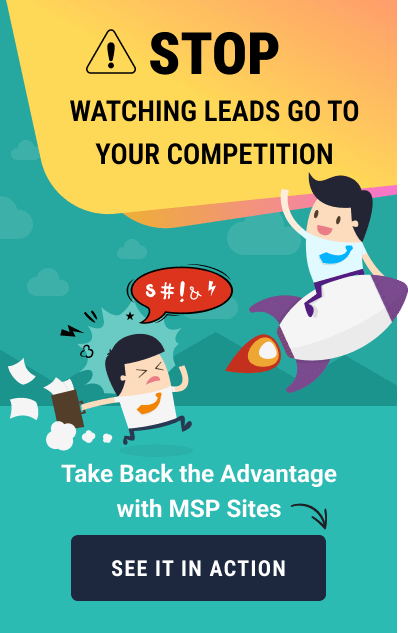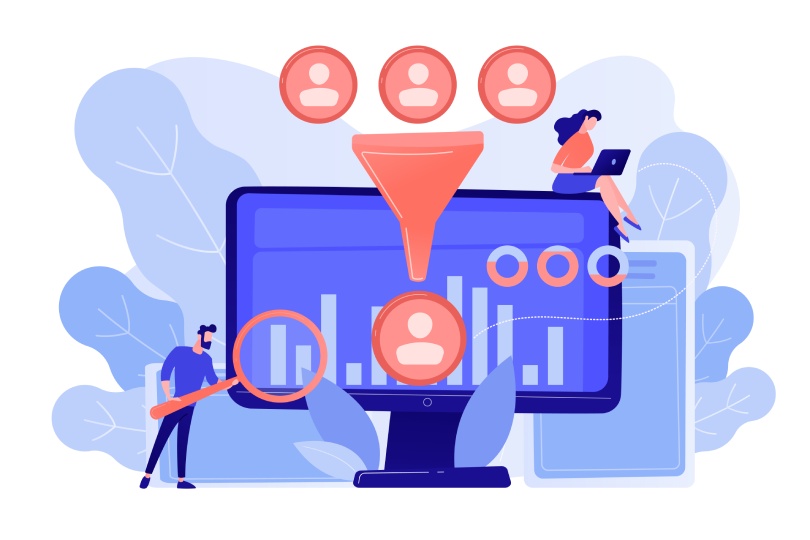
How Effective MSP Website Design Improves Lead Generation
A high-performing website is essential for driving lead generation and growing your MSP business. Your website isn’t just about your online presence—it’s a critical tool for converting visitors into qualified leads and long-term clients.
To achieve this, an effective MSP website must do three things: target the right audience, offer a seamless and professional user experience, and incorporate features that actively generate leads. These elements work together to attract visitors, engage them with relevant content, and guide them toward meaningful actions, such as scheduling a consultation or requesting a quote.
MSP website design isn’t just about aesthetics; it’s about functionality. Features like intuitive navigation, mobile responsiveness, lead capture forms, live chat, and SEO optimization work together to create a seamless user experience. These elements help build trust, establish credibility, and ensure visitors leave with a positive impression of your business. With the right design and tools—which are built into MSP-specific templates—your website can become an MSP lead generation powerhouse, consistently delivering measurable results and supporting your business goals.
Importance of Defining Your Audience for an Effective MSP Website Design
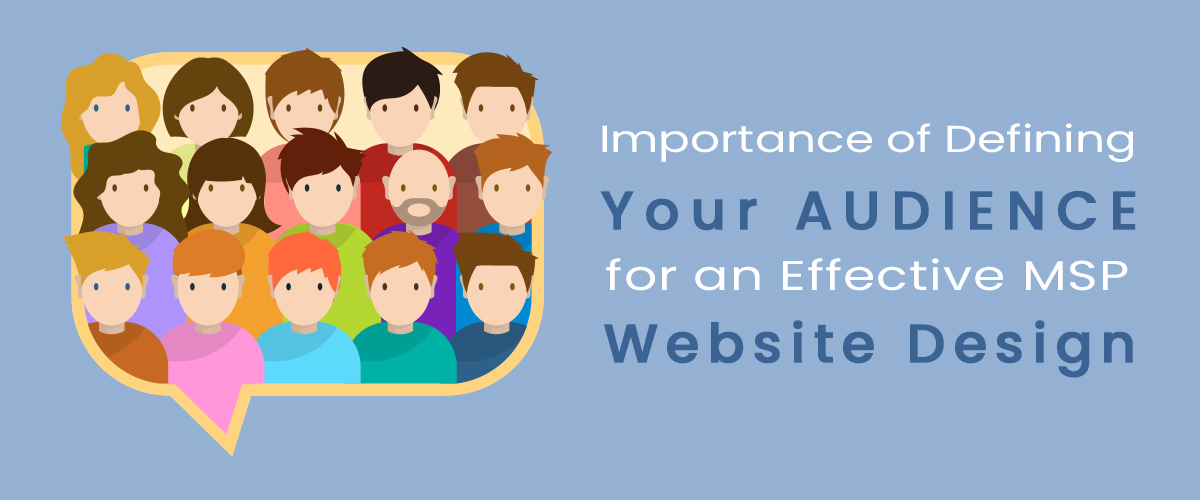
The foundation of a successful MSP website design lies in understanding your audience. Your website must be more than a generic online presence—it should serve as a tailored platform that speaks directly to the needs of your ideal clients. Defining your audience is the first and most crucial step in creating a website that resonates, engages, and converts visitors into leads. Without this clarity, your website risks failing to address the specific problems your potential clients need help solving.
A well-defined audience ensures that every aspect of your MSP website design—messaging, structure, and lead-generation tools—is intentionally crafted to attract the right visitors and guide them toward taking meaningful actions.
Tailored Content and Messaging:
MSP website design isn’t just about aesthetics; it’s about creating a digital experience that aligns with your audience’s needs. By understanding your potential clients, you can craft messaging that resonates:
Small Businesses: Emphasize cost-effective IT solutions and reliable support that reduce downtime.
Enterprises: Highlight advanced features like scalability, compliance, and 24/7 monitoring to address their more complex IT requirements.
Personalized messaging builds trust and ensures your audience sees you as the solution to their challenges.
Guided Website Structure and Navigation:
Your audience influences the layout and navigation of your website. For example:
A small business owner is likely to appreciate quick access to straightforward pricing information and a simple consultation form.
Enterprise clients may prioritize detailed service pages, case studies, and industry-specific solutions.
By tailoring your MSP website design to their preferences, you create an intuitive user experience that encourages visitors to stay longer and explore your services.
Improved Engagement and Conversions:
When your website feels relevant to visitors, they’re more likely to engage with it. Customized CTAs (calls-to-action) based on audience preferences can guide them toward lead-generating actions, such as:
“Get Your Free IT Audit” for small businesses.
“Schedule a Customized IT Strategy Session” for enterprise clients.
Defining your audience is the first step toward designing an MSP website that drives results. With a clear understanding of who you’re targeting, you can build a website that reflects their needs and guides them toward meaningful actions. Next, let’s explore the key design elements that transform your MSP website into a lead-generation powerhouse.
Key Elements of Effective MSP Website Design that Improve Lead Generation
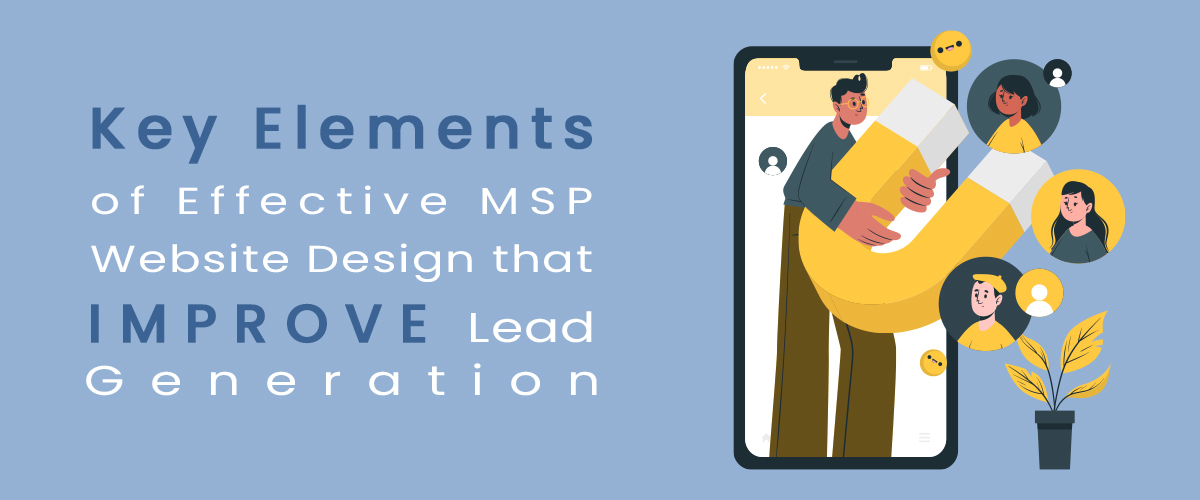
In order to turn your website into a lead-generating machine, you should focus on these core design elements that guide visitors through their journey and encourage them to take action:
1. Clear Navigation and Structure
A well-designed MSP website ensures visitors can quickly find the information they need. Clear navigation and an organized structure guide users to key pages—such as services, pricing, or contact forms—without frustration.
Intuitive navigation is critical for business websites because potential clients often want to quickly understand your offerings. A structured layout with strategically placed calls-to-action (CTAs) encourages visitors to take lead-generating actions, like scheduling a consultation or downloading a resource.
How This Improves Lead Generation:
Simplifies the user journey to key conversion points.
Reduces bounce rates by making the site easier to use.
Pro Tip: If you’re starting with an MSP-specific template, look for one with built-in navigation elements, like dropdown menus or sticky headers, to save time during development.
2. Professional and Credible Visual Appeal
First impressions matter, especially in a competitive industry like IT services. A clean, professional website design not only attracts visitors but also builds trust. High-quality visuals, consistent branding, and a modern layout show that your MSP is reliable and credible.
How This Improves Lead Generation:
Builds trust by presenting your business as professional and organized.
Encourages visitors to stay longer and explore your services.
Pro Tip: Avoid generic stock images; use team photos, client testimonials, or service-specific visuals to connect with your audience. Templates with placeholders for visuals can help you structure these elements effectively.
3. Mobile Responsiveness
With most web traffic now coming from mobile devices, your MSP website must adapt seamlessly to different screen sizes. Mobile-friendly design ensures visitors have a smooth experience, whether they’re browsing on a smartphone, tablet, or desktop.
How This Improves Lead Generation:
Improves user experience, reducing frustration for mobile visitors.
Boosts search engine rankings, as Google prioritizes mobile-friendly websites.
Pro Tip: Look for templates that are optimized for mobile responsiveness, with layouts that adjust automatically for smaller screens. This saves time and ensures your website is accessible to all users.
4. Lead Generation Tools and Features
An MSP website design should actively drive conversions by incorporating tools that make it easy for visitors to take action. Lead capture forms, live chat, appointment scheduling, and downloadable resources are all essential features for turning visitors into leads.
How This Improves Lead Generation:
Provides multiple opportunities for visitors to engage with your business.
Streamlines the process of capturing potential client information.
Pro Tip: Use strategically placed CTAs, such as “Schedule a Free Consultation” or “Get Your IT Assessment,” to encourage visitors to share their information.
5. SEO-Friendly Design
Search engine optimization (SEO) is essential for attracting organic traffic to your website. MSP Website SEO focuses on optimizing your site to target managed service provider-related searches, helping you rank higher for industry-specific keywords. A well-designed MSP website includes features like customizable metadata, headers, alt text, and clean URLs to boost visibility on search engine results pages.
How This Improves Lead Generation:
Ensures your website is discoverable by potential clients searching for MSP services.
Drives more organic traffic to your site, increasing conversion opportunities.
Pro Tip: Use keywords like “Managed IT Services in [Your Location]” throughout your website to target local clients.
6. Showcase Social Proof
Social proof builds credibility and reassures potential clients that your MSP delivers results. Include:
Client Testimonials: Feedback from satisfied clients validates your expertise.
Case Studies: Showcase detailed examples of how you’ve solved challenges for other businesses.
Positive Reviews: Highlight reviews from platforms like Google or industry-specific directories.
Pro Tip: Encourage satisfied clients to leave reviews on platforms like Google or industry-specific directories. Respond to all reviews—positive or negative—to show your commitment to customer satisfaction and professionalism.
By including these key elements, an MSP website design can become a powerful tool for lead generation. A well-structured, professional, and mobile-responsive website not only attracts the right audience but also converts visitors into valuable leads through engaging content and integrated lead capture tools.
Once you’ve incorporated these key design elements, the next step is to leverage tools that optimize lead generation further.
Tools and Features That Optimize Lead Generation
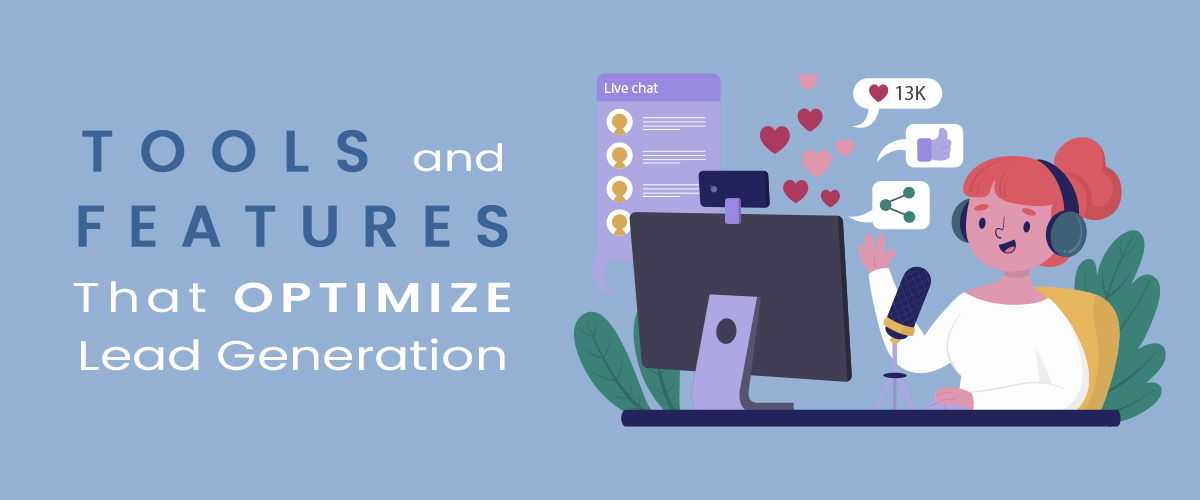
Equipping your website with the right tools can transform it into a lead-generating powerhouse. These features improve engagement, build trust, and convert visitors into paying clients:
1. Live Chat Integration
Live chat allows you to provide instant, personalized responses to visitors’ questions, keeping them engaged and building trust. Whether they’re inquiring about your services or seeking clarification, live chat creates a personal connection that reduces bounce rates and drives conversions. It’s important to note that chatbots or AI tools should not replace real human interaction. Visitors value authentic communication, so ensuring a live person is available to assist them enhances the overall user experience and fosters stronger relationships with potential clients.
2. Appointment Scheduling
Streamline the process for scheduling consultations by integrating an appointment booking tool. This eliminates back-and-forth communication and allows potential clients to select a convenient time to meet with your team.
3. Automated Follow-Ups
Use automated email or SMS campaigns to nurture leads who have shown interest. For example, if someone downloads a resource, send them a series of follow-up emails with helpful content and reminders to schedule a consultation.
4. Visitor Analytics
Tracking how visitors interact with your website provides valuable insights for improvement. Tools like Google Analytics or Hotjar can show you which pages are performing well, where visitors drop off, and which content drives the most engagement. Your website isn’t a one-and-done project. Use visitor analytics to continuously refine your content, CTAs, and overall strategy. Key metrics to track include:
Bounce Rates: High bounce rates may indicate navigation or content issues.
Session Durations: Longer sessions suggest visitors are engaged with your content.
Conversion Rates: Monitor how well your lead capture tools and CTAs are performing.
5. Unified CRM & Marketing Suite
A unified CRM and MSP marketing suite brings together chat, scheduling, and analytics while offering advanced tools like email marketing, social media scheduling, and AI-driven responses to reviews. It keeps your leads organized and nurtured throughout the sales funnel, helping MSPs attract and convert more clients efficiently.
Turn Your MSP Website into a Lead-Generating Powerhouse
Effective MSP website design goes beyond appearances—it’s about creating a seamless, intuitive experience that encourages visitors to take action. A well-designed website prioritizes the needs of users, incorporates advanced tools like live chat and lead capture forms, and uses strategic optimization to improve engagement. By harnessing these elements, MSPs can transform their websites into powerful lead-generation platforms that not only attract visitors but also convert them into long-term clients.
Ready to unlock your website’s full potential? Schedule a 1-1 Demo Call with MSPsites for customized solutions that turn your site into a lead-generating powerhouse.

How Effective MSP Website Design Improves Lead Generation
A high-performing website is essential for driving lead generation and growing your MSP business. Your website isn’t just about your online presence—it’s a critical tool for converting visitors into qualified leads and long-term clients.
To achieve this, an effective MSP website must do three things: target the right audience, offer a seamless and professional user experience, and incorporate features that actively generate leads. These elements work together to attract visitors, engage them with relevant content, and guide them toward meaningful actions, such as scheduling a consultation or requesting a quote.
MSP website design isn’t just about aesthetics; it’s about functionality. Features like intuitive navigation, mobile responsiveness, lead capture forms, live chat, and SEO optimization work together to create a seamless user experience. These elements help build trust, establish credibility, and ensure visitors leave with a positive impression of your business. With the right design and tools—which are built into MSP-specific templates—your website can become an MSP lead generation powerhouse, consistently delivering measurable results and supporting your business goals.
Importance of Defining Your Audience for an Effective MSP Website Design

The foundation of a successful MSP website design lies in understanding your audience. Your website must be more than a generic online presence—it should serve as a tailored platform that speaks directly to the needs of your ideal clients. Defining your audience is the first and most crucial step in creating a website that resonates, engages, and converts visitors into leads. Without this clarity, your website risks failing to address the specific problems your potential clients need help solving.
A well-defined audience ensures that every aspect of your MSP website design—messaging, structure, and lead-generation tools—is intentionally crafted to attract the right visitors and guide them toward taking meaningful actions.
Tailored Content and Messaging:
MSP website design isn’t just about aesthetics; it’s about creating a digital experience that aligns with your audience’s needs. By understanding your potential clients, you can craft messaging that resonates:
Small Businesses: Emphasize cost-effective IT solutions and reliable support that reduce downtime.
Enterprises: Highlight advanced features like scalability, compliance, and 24/7 monitoring to address their more complex IT requirements.
Personalized messaging builds trust and ensures your audience sees you as the solution to their challenges.
Guided Website Structure and Navigation:
Your audience influences the layout and navigation of your website. For example:
A small business owner is likely to appreciate quick access to straightforward pricing information and a simple consultation form.
Enterprise clients may prioritize detailed service pages, case studies, and industry-specific solutions.
By tailoring your MSP website design to their preferences, you create an intuitive user experience that encourages visitors to stay longer and explore your services.
Improved Engagement and Conversions:
When your website feels relevant to visitors, they’re more likely to engage with it. Customized CTAs (calls-to-action) based on audience preferences can guide them toward lead-generating actions, such as:
“Get Your Free IT Audit” for small businesses.
“Schedule a Customized IT Strategy Session” for enterprise clients.
Defining your audience is the first step toward designing an MSP website that drives results. With a clear understanding of who you’re targeting, you can build a website that reflects their needs and guides them toward meaningful actions. Next, let’s explore the key design elements that transform your MSP website into a lead-generation powerhouse.
Key Elements of Effective MSP Website Design that Improve Lead Generation

In order to turn your website into a lead-generating machine, you should focus on these core design elements that guide visitors through their journey and encourage them to take action:
1. Clear Navigation and Structure
A well-designed MSP website ensures visitors can quickly find the information they need. Clear navigation and an organized structure guide users to key pages—such as services, pricing, or contact forms—without frustration.
Intuitive navigation is critical for business websites because potential clients often want to quickly understand your offerings. A structured layout with strategically placed calls-to-action (CTAs) encourages visitors to take lead-generating actions, like scheduling a consultation or downloading a resource.
How This Improves Lead Generation:
Simplifies the user journey to key conversion points.
Reduces bounce rates by making the site easier to use.
Pro Tip: If you’re starting with an MSP-specific template, look for one with built-in navigation elements, like dropdown menus or sticky headers, to save time during development.
2. Professional and Credible Visual Appeal
First impressions matter, especially in a competitive industry like IT services. A clean, professional website design not only attracts visitors but also builds trust. High-quality visuals, consistent branding, and a modern layout show that your MSP is reliable and credible.
How This Improves Lead Generation:
Builds trust by presenting your business as professional and organized.
Encourages visitors to stay longer and explore your services.
Pro Tip: Avoid generic stock images; use team photos, client testimonials, or service-specific visuals to connect with your audience. Templates with placeholders for visuals can help you structure these elements effectively.
3. Mobile Responsiveness
With most web traffic now coming from mobile devices, your MSP website must adapt seamlessly to different screen sizes. Mobile-friendly design ensures visitors have a smooth experience, whether they’re browsing on a smartphone, tablet, or desktop.
How This Improves Lead Generation:
Improves user experience, reducing frustration for mobile visitors.
Boosts search engine rankings, as Google prioritizes mobile-friendly websites.
Pro Tip: Look for templates that are optimized for mobile responsiveness, with layouts that adjust automatically for smaller screens. This saves time and ensures your website is accessible to all users.
4. Lead Generation Tools and Features
An MSP website design should actively drive conversions by incorporating tools that make it easy for visitors to take action. Lead capture forms, live chat, appointment scheduling, and downloadable resources are all essential features for turning visitors into leads.
How This Improves Lead Generation:
Provides multiple opportunities for visitors to engage with your business.
Streamlines the process of capturing potential client information.
Pro Tip: Use strategically placed CTAs, such as “Schedule a Free Consultation” or “Get Your IT Assessment,” to encourage visitors to share their information.
5. SEO-Friendly Design
Search engine optimization (SEO) is essential for attracting organic traffic to your website. MSP Website SEO focuses on optimizing your site to target managed service provider-related searches, helping you rank higher for industry-specific keywords. A well-designed MSP website includes features like customizable metadata, headers, alt text, and clean URLs to boost visibility on search engine results pages.
How This Improves Lead Generation:
Ensures your website is discoverable by potential clients searching for MSP services.
Drives more organic traffic to your site, increasing conversion opportunities.
Pro Tip: Use keywords like “Managed IT Services in [Your Location]” throughout your website to target local clients.
6. Showcase Social Proof
Social proof builds credibility and reassures potential clients that your MSP delivers results. Include:
Client Testimonials: Feedback from satisfied clients validates your expertise.
Case Studies: Showcase detailed examples of how you’ve solved challenges for other businesses.
Positive Reviews: Highlight reviews from platforms like Google or industry-specific directories.
Pro Tip: Encourage satisfied clients to leave reviews on platforms like Google or industry-specific directories. Respond to all reviews—positive or negative—to show your commitment to customer satisfaction and professionalism.
By including these key elements, an MSP website design can become a powerful tool for lead generation. A well-structured, professional, and mobile-responsive website not only attracts the right audience but also converts visitors into valuable leads through engaging content and integrated lead capture tools.
Once you’ve incorporated these key design elements, the next step is to leverage tools that optimize lead generation further.
Tools and Features That Optimize Lead Generation

Equipping your website with the right tools can transform it into a lead-generating powerhouse. These features improve engagement, build trust, and convert visitors into paying clients:
1. Live Chat Integration
Live chat allows you to provide instant, personalized responses to visitors’ questions, keeping them engaged and building trust. Whether they’re inquiring about your services or seeking clarification, live chat creates a personal connection that reduces bounce rates and drives conversions. It’s important to note that chatbots or AI tools should not replace real human interaction. Visitors value authentic communication, so ensuring a live person is available to assist them enhances the overall user experience and fosters stronger relationships with potential clients.
2. Appointment Scheduling
Streamline the process for scheduling consultations by integrating an appointment booking tool. This eliminates back-and-forth communication and allows potential clients to select a convenient time to meet with your team.
3. Automated Follow-Ups
Use automated email or SMS campaigns to nurture leads who have shown interest. For example, if someone downloads a resource, send them a series of follow-up emails with helpful content and reminders to schedule a consultation.
4. Visitor Analytics
Tracking how visitors interact with your website provides valuable insights for improvement. Tools like Google Analytics or Hotjar can show you which pages are performing well, where visitors drop off, and which content drives the most engagement. Your website isn’t a one-and-done project. Use visitor analytics to continuously refine your content, CTAs, and overall strategy. Key metrics to track include:
Bounce Rates: High bounce rates may indicate navigation or content issues.
Session Durations: Longer sessions suggest visitors are engaged with your content.
Conversion Rates: Monitor how well your lead capture tools and CTAs are performing.
5. Unified CRM & Marketing Suite
A unified CRM and MSP marketing suite brings together chat, scheduling, and analytics while offering advanced tools like email marketing, social media scheduling, and AI-driven responses to reviews. It keeps your leads organized and nurtured throughout the sales funnel, helping MSPs attract and convert more clients efficiently.
Turn Your MSP Website into a Lead-Generating Powerhouse
Effective MSP website design goes beyond appearances—it’s about creating a seamless, intuitive experience that encourages visitors to take action. A well-designed website prioritizes the needs of users, incorporates advanced tools like live chat and lead capture forms, and uses strategic optimization to improve engagement. By harnessing these elements, MSPs can transform their websites into powerful lead-generation platforms that not only attract visitors but also convert them into long-term clients.
Ready to unlock your website’s full potential? Schedule a 1-1 Demo Call with MSPsites for customized solutions that turn your site into a lead-generating powerhouse.


